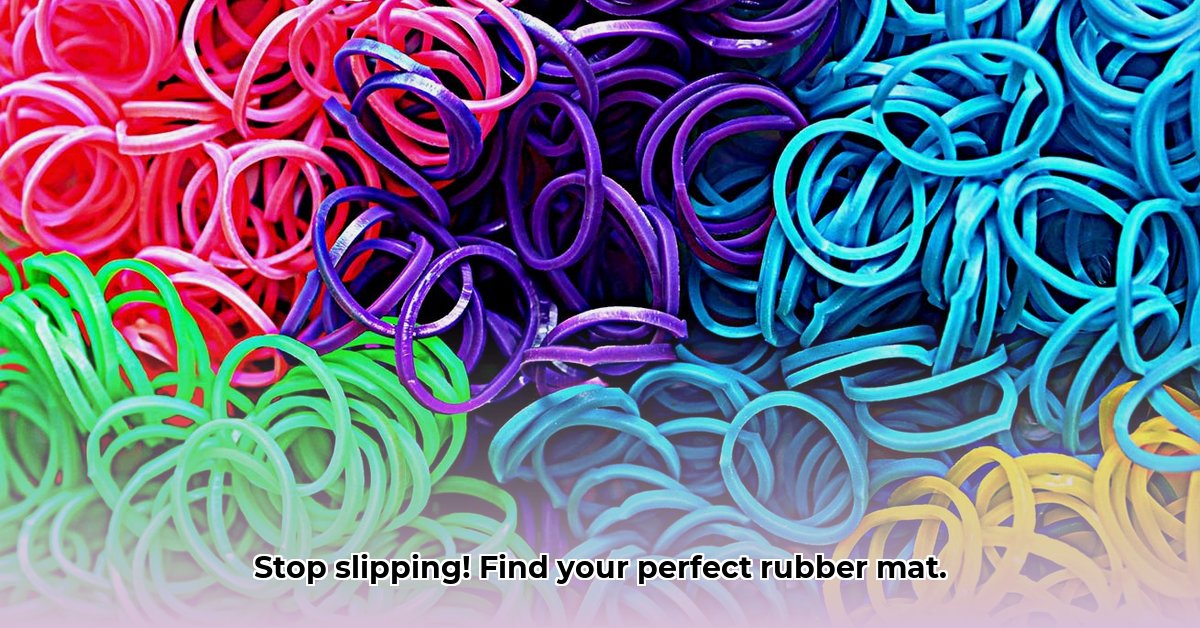Choosing the right rubber mat roll can be overwhelming, given the vast array of options available for home gyms, garages, workshops, and industrial settings. This comprehensive guide simplifies the selection process, helping you identify the ideal mat based on your unique requirements and budget. We’ll delve into the different types of rubber mats, essential features, and key considerations to ensure you make an informed decision. For more durable options, consider rubber deck tiles.
Your Ultimate Guide to Rubber Mat Rolls
Selecting the perfect rubber mat roll doesn’t have to be a daunting task. This comprehensive guide provides a step-by-step approach to navigating the diverse options available, ensuring you find the ideal solution for your specific needs, whether it’s a home gym, workshop, or commercial space.
Understanding Your Options: Material, Thickness, and Texture Explained
The world of rubber mat rolls presents a wide range of choices. The first crucial decision involves selecting the appropriate material: virgin rubber, recycled rubber, or a rubber composite.
- Virgin Rubber: This option boasts exceptional durability, resilience, and longevity. It withstands heavy use and harsh conditions, making it ideal for demanding environments. However, virgin rubber comes at a higher price point and has a larger environmental footprint compared to recycled alternatives.
- Recycled Rubber: An eco-conscious choice, recycled rubber utilizes repurposed materials, offering a sustainable and cost-effective solution. While it may not match the lifespan of virgin rubber in extreme conditions, it provides excellent performance for a wide range of applications.
- Rubber Composites: These engineered materials blend virgin and recycled rubber, potentially with other polymers, to achieve specific performance characteristics (e.g., increased chemical resistance, enhanced slip resistance).
Next, consider the thickness of the mat roll which directly impacts cushioning and shock absorption. Thicker rolls (typically exceeding 3/8 inch) are recommended for high-impact areas like home gyms and weightlifting zones, providing superior floor protection and joint support. Thinner rolls are suitable for lighter applications, such as protecting garage floors from scratches and minor impacts.
Surface texture significantly influences slip resistance. Textured surfaces enhance safety, particularly in areas prone to spills or moisture, such as kitchens, bathrooms, and workshops. Smooth surfaces are easier to clean but can become slippery when wet, necessitating caution. Some rubber mats feature specialized textures designed to improve grip even when exposed to oil or other substances.
| Feature | Virgin Rubber | Recycled Rubber | Rubber Composite |
|---|---|---|---|
| Durability | Excellent; longest lifespan; resists wear and tear in demanding applications. | Good; potentially shorter lifespan compared to virgin rubber, but still durable for many applications. | Varies depending on composition; can be engineered for specific durability requirements. |
| Cost | Typically higher; reflects the premium quality and longevity. | Generally lower; offers a budget-friendly and environmentally responsible option. | Medium to High; Price depends on the specific blend of materials and performance enhancements. |
| Environmental Impact | Higher initial impact due to resource extraction, but recyclable at the end of its life. | Lower initial impact due to material reuse; contributes to waste reduction and resource conservation. | Depends on the composition; can range from low to medium depending on the amount of recycled content used. |
| Slip Resistance | Depends on texture; can be easily improved with texturing or specialized surface treatments. | Depends on texture; can be enhanced with texturing or coatings. | Depends on the composition and surface treatment; can be engineered for high slip resistance. |
| Impact Absorption | Excellent; provides superior cushioning and shock absorption, ideal for high-impact activities. | Good; provides adequate cushioning for many applications; may not be sufficient for heavy weightlifting. | Varies depending on the composition; can be tailored for specific impact absorption needs. |
| Chemical Resistance | Generally good resistance to common chemicals; may require specialized formulations for specific industrial applications. | Varies; may be less resistant to certain chemicals compared to virgin rubber. | Can be significantly enhanced by using specific polymers in the composite mix. |
Vital Factors to Ponder Before Purchasing
Before making a purchase, carefully consider the following factors to ensure you select the most appropriate rubber mat roll for your specific application. What critical attributes differentiate one rubber mat roll from another?
- Thickness: Assess the impact the mat will need to absorb. A thicker roll provides greater comfort and enhanced floor protection but typically comes with a higher price tag.
- Density: A higher density mat will generally be more durable and resistant to wear and tear, especially in high-traffic areas.
- Recycled Content: Opting for recycled rubber demonstrates environmental responsibility, promoting a circular economy. Be aware that recycled rubber may exhibit slight variations in durability compared to virgin rubber. Verify the percentage of recycled content, as higher percentages often indicate a greater environmental benefit.
- Durability: Comparing the longevity of different mat rolls can be challenging due to inconsistent standardized testing across brands. User reviews, manufacturer specifications, and warranty information provide valuable insights. A comprehensive warranty reflects the manufacturer’s confidence in their product’s durability.
- Slip Resistance: Prioritize slip resistance for safety, especially in environments where spills or moisture are likely. Look for mats with textured surfaces or specialized coatings to enhance grip. Check the static coefficient of friction (SCOF) rating to assess the mat’s slip resistance. A higher SCOF indicates better slip resistance.
- Installation: Some rolls feature adhesive backing for permanent installation, while others require double-sided tape or other adhesives. Consider the ease of installation and potential removal needs. Interlocking edges can simplify installation and create a seamless appearance.
- Price: Prices vary significantly based on size, thickness, material, brand, and features. Establish a budget beforehand to avoid overspending. Compare prices from multiple vendors to ensure you’re getting the best deal.
- Warranty: A robust warranty provides peace of mind and protects your investment against manufacturing defects or premature wear. Review the warranty terms and conditions carefully to understand the coverage and limitations.
- Chemical Resistance: If the mat will be exposed to chemicals, oils, or solvents, ensure it has adequate chemical resistance. Check the manufacturer’s specifications for specific chemical resistance ratings.
- Fire Resistance: In certain applications, fire resistance may be a critical consideration. Look for mats that meet relevant fire safety standards and regulations.
Top Rubber Mat Roll Recommendations: Application-Specific Considerations
The ideal rubber mat roll depends heavily on the intended use. Here’s a breakdown of application-specific recommendations to guide your selection: In what scenarios do particular mats excel?
For Home Gyms: Choose a thicker roll (at least 3/8″) with excellent impact absorption and high slip resistance. This will protect your floors and provide a safe, comfortable workout surface. Consider interlocking mats for easier installation and a more seamless appearance.
For Industrial Settings: Prioritize extreme durability and chemical resistance. Look for mats with exceptional thickness and specialized features tailored to the specific application such as resistance to oils, solvents, or acids. Anti-fatigue properties can also improve worker comfort and productivity.
For Commercial Kitchens: Focus on slip resistance, grease resistance, and ease of cleaning. Look for mats with drainage holes to prevent liquid accumulation and promote hygiene. Anti-microbial properties can also help prevent the growth of bacteria and mold.
Budget-Friendly Solutions: Recycled rubber rolls offer a cost-effective option without compromising too much on performance. They’re suitable for less demanding applications, but remember they might not last as long as virgin rubber rolls. Consider thinner rolls to further reduce costs, but be mindful of the reduced impact absorption.
Maintaining Your Rubber Mat Roll: Longevity Through Proper Care
Proper maintenance is essential for maximizing the lifespan of your rubber mat roll. Regular sweeping or vacuuming removes loose debris and prevents dirt buildup. Clean spills immediately to avoid staining and potential damage. For stubborn stains, use a mild detergent solution and a soft brush. Avoid harsh chemicals, abrasive cleaners, and power washers, as they can damage the mat’s surface. Some manufacturers offer specialized cleaning products designed for rubber mats.
Final Thoughts: Making the Right Choice
Choosing the right rubber mat roll involves carefully considering a range of interconnected factors. By evaluating the pros and cons of different materials, thicknesses, and textures, and by paying close attention to durability, slip resistance, installation methods, and intended use, you’ll be well-equipped to select the perfect mat for your specific needs. Remember to consult user reviews, compare warranties, and seek expert advice to make the most informed decision possible.
Evaluating Rubber Flooring Roll Durability Across Brands
Rubber flooring rolls offer a resilient and economical solution for covering large areas. Selecting the right roll depends on factors such as thickness, recycled content, slip resistance, intended use, and long-term durability. This guide provides a framework for evaluating different brands and options to ensure you make the best choice for your application. Are you prepared to choose the product that best fits your needs?
- Rubber flooring rolls provide a durable and cost-effective solution for large areas.
- Selecting the right roll depends on factors like thickness, recycled content, slip resistance, and intended use.
- Understanding the limitations of standardized testing requires careful evaluation of manufacturer warranties and user reviews.
Navigating the Complexities of Rubber Mat Roll Selection
You’ve decided on rubber flooring rolls. Great choice! But with a plethora of brands and options available, how do you make the right decision? The key lies in understanding what to look
- Kitchen tiling wall: Elevate your kitchen with stylish wall tiles - December 16, 2025
- Gray Kitchen Backsplash Tile: Ideas for a Stylish Upgrade - December 14, 2025
- Backsplash For Gray Cabinets: Choosing the Right Backsplash Style - December 13, 2025









